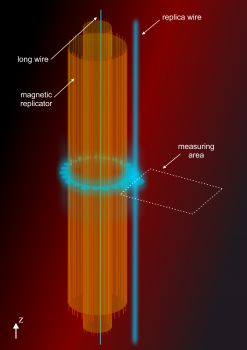Oct 29 2020
A group of researchers, with two physicists from the University of Sussex, have discovered a way to bypass a 178-year-old theory, which would enable them to successfully stop magnetic fields at a distance.
 Physicists circumvent centuries-old theory to cancel magnetic fields. Image Credit: University of Sussex
Physicists circumvent centuries-old theory to cancel magnetic fields. Image Credit: University of Sussex
It is the first time this feat has been achieved with real-world advantages. It is expected that this research will have a broad range of applications. For instance, patients with neurological diseases such as Parkinson’s or Alzheimer’s could, in the future, receive a more precise diagnosis.
The ability to stop “noisy” external magnetic fields will enable doctors using magnetic field scanners to see more what occurs in the brain more accurately.
The research paper titled “Tailoring magnetic fields in inaccessible regions” has been published in Physical Review Letters. It is an international partnership between Dr Mark Bason and Jordi Prat-Camps from the University of Sussex, and Rosa Mach-Batlle and Nuria Del-Valle from the Universitat Autonoma de Barcelona and other institutions.
Proposed in 1842, “Earnshaw’s Theorem” restricts the potential to shape magnetic fields. The team was able to devise a groundbreaking technique to bypass this theory to successfully stop other magnetic fields that can interfere with readings in experiments.
They realized this by developing a device composed of a prudent arrangement of electrical wires. This forms more fields and thus neutralizes the effects of the undesirable magnetic field. This has been a significant challenge for researchers for years, but now the team has discovered a new strategy to handle these challenging fields.
Although a similar feat has been realized at considerably higher frequencies, this would be the first time it has been realized at low frequencies and static fields—like biological frequencies—which will unravel a multitude of beneficial applications.
This research may also have an impact on some future applications, such as:
- Quantum computing and quantum technology, wherein “noise” from external magnetic fields can influence experimental readings
- Biomedicine, to properly regulate and control nanorobots and magnetic nanoparticles sent inside a body, using external magnetic fields. Possible applications for this development include enhanced drug delivery and magnetic hyperthermia therapies.
- Neuroimaging, wherein a method called “transcranial magnetic stimulation” triggers various areas of the brain using magnetic fields. Applying the methods described in this study, doctors may be able to more prudently look into areas of the brain that require stimulation.
Starting from the fundamental question of whether it was possible or not to create a magnetic source at a distance, we came up with a strategy for controlling magnetism remotely that we believe could have a significant impact in technologies relying on the magnetic field distribution in inaccessible regions, such as inside of a human body.
Dr Rosa Mach-Batlle, Study Lead Author, Universitat Autonoma de Barcelona
“We’ve discovered a way to circumvent Earnshaw’s theorem which many people didn’t imagine was possible,” stated Dr Mark Bason from the School of Mathematical and Physical Sciences at the University of Sussex.
As a physicist, that’s pretty exciting. But it’s not just a theoretical exercise as our research might lead to some really important applications: more accurate diagnosis for Motor Neurone Disease patients in future, for example, better understanding of dementia in the brain, or speeding the development of quantum technology.
Dr Mark Bason, School of Mathematical and Physical Sciences, University of Sussex
The Science in More Detail
For a long time, researchers have been making efforts to manipulate magnetism. In this study, the team has shown that they can imitate the magnetic field of a straight current wire by using a metamaterial, i.e., the device they created has been built to display particular electromagnetic properties.
They could successfully negate one magnetic field by forming other neutralizing magnetic fields. It is an exceptional breakthrough with prospective wider real-world applications.
Journal Reference:
Mach-Batlle, R., et al. (2020) Tailoring Magnetic Fields in Inaccessible Regions. Physical Review Letters. doi.org/10.1103/PhysRevLett.125.177204.